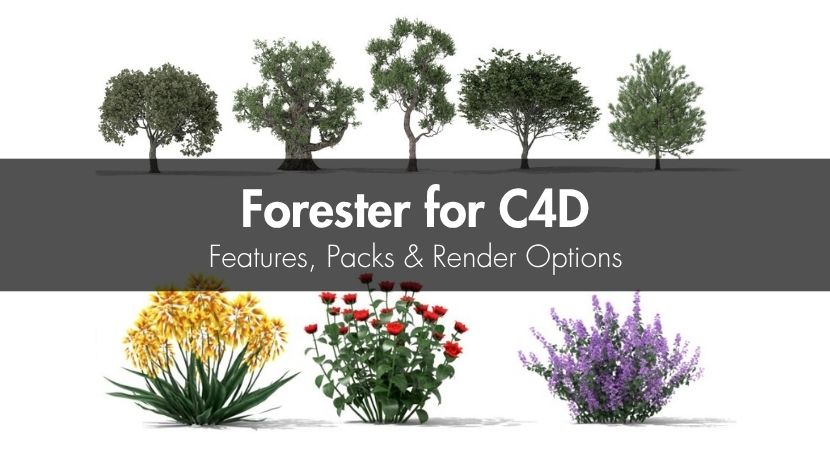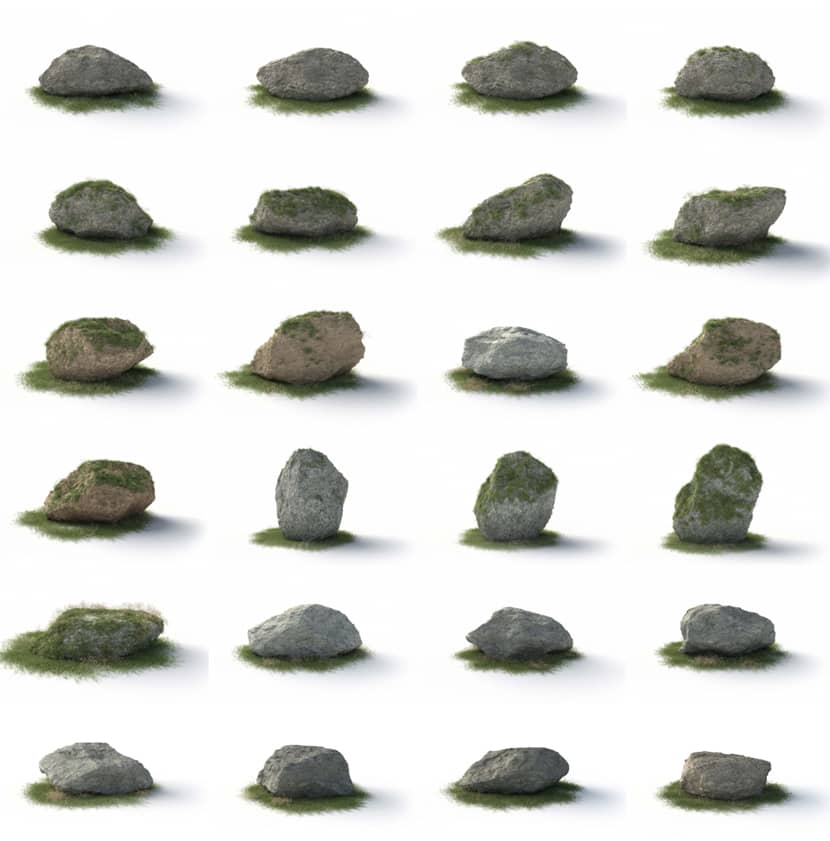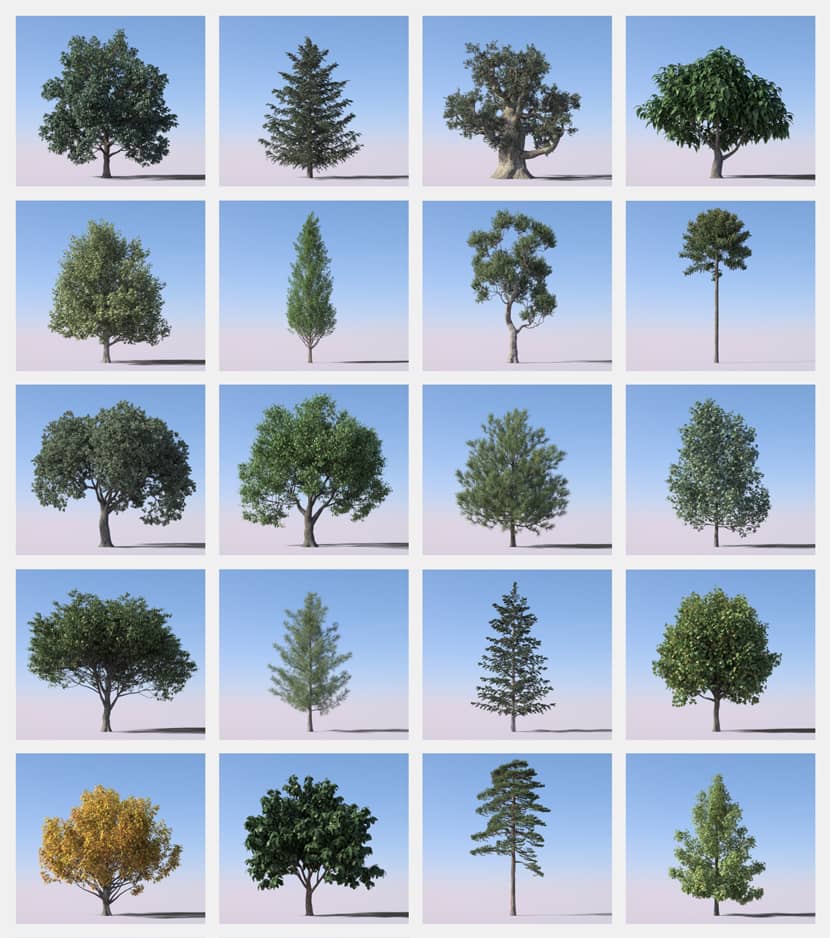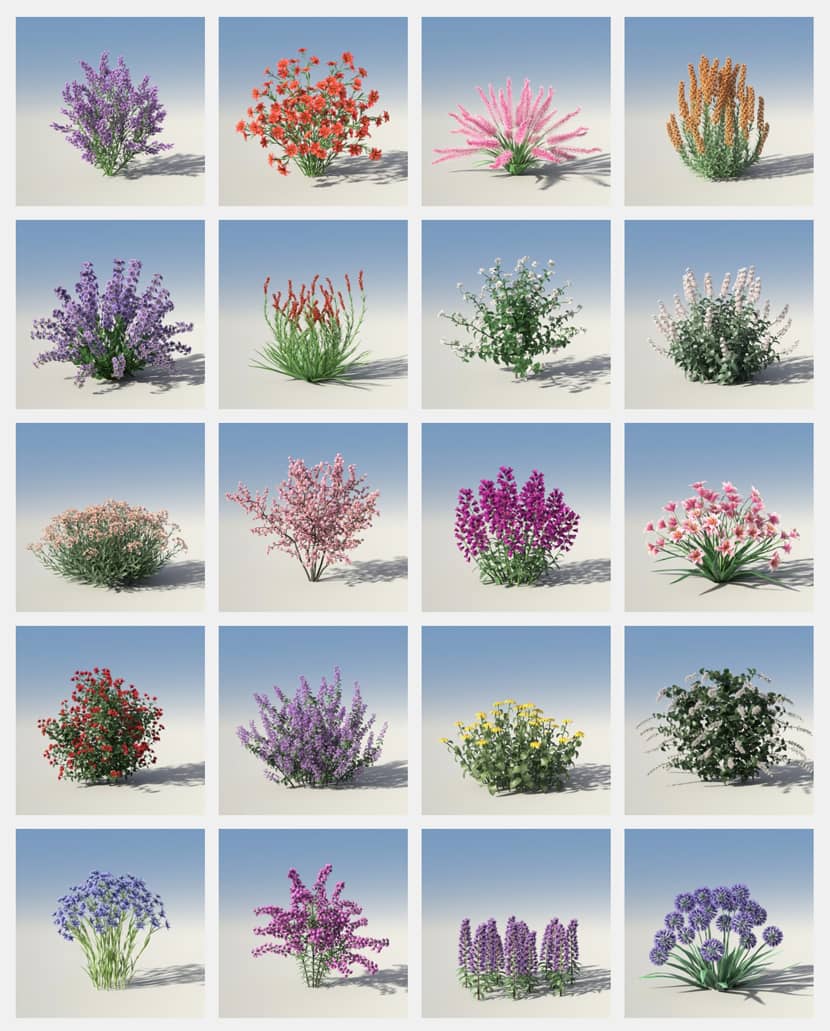
One of the most difficult artistic and technical tasks for 3D artists has always been creating realistic, natural environments in Cinema 4D. For anyone who needs to add procedural flora, rocks, and other natural aspects to outdoor scenes without taxing their system, 3DQuakers' Forester plugin has become a vital tool. Read the article and learn more about this handful tool!
We'll go over Forester's main modules, expansion packs, rendering compatibility, and performance optimization advice in this extensive tutorial. We'll also cover how to fully utilize RebusFarm's cloud rendering for quicker and more effective outcomes.
What Is the Forester Plugin for Cinema 4D?
3DQuakers created Forester, a toolkit for creating procedural environments in Cinema 4D. With comprehensive procedural controls and physically realistic behavior, it enables artists to create trees, plants, rocks, and other natural components directly within the software.
Forester generates vegetation that reacts dynamically to factors like wind, age, and seasons rather than depending on bulky static models. It's widely used in game design, film, and architectural visualization, enabling producers to quickly and easily create realistic outdoor scenes.
Without the use of third-party scripts or external resources, its four primary modules, Forester Trees, Multiflora, MultiCloner, and Rocks, cooperate to produce lush and organic landscapes.
🎥 Watch the official Forester tutorials on how to create a tree from scratch:
How Do Forester Trees Work?
The core of the plugin is the Forester Trees module. Users can create procedural trees using it by varying factors such as growth stages, leaf type, branch density, and trunk curvature.
The plugin has a wide variety of presets for easy use, and each tree can be individually sculpted or randomized to resemble real-world species. Because trees are constructed using parametric geometry, you can change them whenever you want, even after they've been placed.
Forester Wind, an integrated system that gives branches and leaves organic motion, is one of the most adored aspects. The wind is perfect for stills and animations because it is completely controlled. To produce delicate breezes or complete storm scenes, users can adjust motion's intensity or direction while previewing it in the viewport.
What Features Does Multiflora Provide?
Forester's capabilities are expanded to grass, flowers, and small plants by Multiflora. Similar to the tree module, it is lightweight and procedural, and it can fill expansive areas with vegetation that appears diverse and organic.
Realistic characteristics like stem bending, unpredictability, and shading modifications are used to grow each part. The main benefit of Multiflora is that it can automatically adjust plants to uneven terrain, saving hours of laborious manual adjustments.
Because of its memory efficiency, artists can add thousands of grass or wildflower blades to expansive vistas without noticeably slowing down the viewport.
🎥 See Multiflora in action:
How Does MultiCloner Handle Scattering?
Compared to Cinema 4D's native cloner, the MultiCloner module provides far more realistic results by handling object distribution and scattering. It provides artists with fine geological control by allocating assets according to material zones, slope, or altitude.
With MultiCloner, you may use unique randomness for each instance when scattering rocks, plants, or even entire tree systems. Additionally, it works flawlessly with the built-in deformers in Cinema 4D, enabling dynamic interaction with other geometry like terrain or architectural features.
Every render will feel natural thanks to this procedural scattering system, which steers clear of the mechanical placement and repetition that frequently mar natural scenes.
🎥 Watch the full MultiCloner tutorial series below for a deeper learning:
MultiCloner 1 Distribution Patterns 1
MultiCloner 2 Distribution Patterns 2
MultiCloner 3 Distribution Patterns 3
MultiCloner 4 Distribution Bias
MultiCloner 5 Scatter Parameters
MultiCloner 6 Transform and Randomization
MultiCloner 7 Distribute On Curve
MultiCloner 8 Growth
MultiCloner 9 Filtering 1
What Can You Do With Forester Rock?
Several deformation controls can be used to shape the procedural rock formations produced by the Forester Rock module. To replicate accurate geological forms, artists can manipulate surface irregularities, erosion levels, and even layer blending.
Every rock has a smooth texture arrangement that is compatible with all renderers. When used in conjunction with MultiCloner, you may rapidly add precisely varied stones to garden settings, mountain slopes, and riverbeds.
In order to guarantee that no two assets ever appear the same, even when duplicated or dispersed across wide areas, Forester Rock additionally facilitates texture randomization.
The Forester Rock module in Forester for Cinema 4D was used to build this set of rock objects. There is no material displacement involved in these rock objects. The rock basic user interface allows for direct adjustment of rock detail. After that, Rocks can be saved for use in other projects in the Cinema 4D preset browser.

What Are The Requirements And Compatibility Of Forester?
Forester is compatible with Cinema 4D R18 and later on both Windows and macOS. It works seamlessly with most major third-party renderers, including Redshift, Arnold, Octane, Corona, and V-Ray.
Users working with Redshift often ask: “How do I use Forester with Redshift in C4D?” The answer is simple — Forester’s materials automatically adapt to Redshift shaders, requiring minimal manual setup.
For best performance, users should ensure at least 16 GB of RAM, a multi-core CPU, and a dedicated GPU with 6 GB VRAM or higher.
What Does Forester Expansion Pack 1: Production Trees Include?
More than 50 excellent tree elements that are streamlined for speed and authenticity are included in Expansion Pack 1-Production Trees. Users can choose from a variety of project kinds, including icy winter vistas and lush summer forests, thanks to each tree's capacity for wind animation and seasonal variations.

The Renderer Selector included in the bundle makes it simple to choose between materials that are optimized for Octane, Corona, or Redshift. This eliminates the need to manually tweak shaders and guarantees that you always receive the best possible image.
🎥 Watch the official overview of Forester Expansion Pack 1:
What Are the Key Features of Production Trees?
For optimal use in various scenarios, each tree in this collection comes in three versions: Adult, Young, and Low-Poly. Alpha-mapped textures are used in the leaves, which combine effective rendering performance with visual richness.
With just one click, artists can switch between the spring, summer, fall, and winter seasonal texture sets, instantly adapting their sceneries to suit various moods or weather conditions.
Production trees are perfect for architectural visualization and cinematic settings where performance and detail are crucial because they are made for professional operations.
What Does Forester Expansion Pack 2: Flowering Shrubs Include?
The goal of Expansion Pack 2-Flowering Shrubs is to create color variation and little vegetation. It features more than 50 intricate shrubs, including wild roses, hydrangeas, azaleas, and lavenders, that can be programmatically altered.

Every model has materials tuned for several renderers and support for wind animation. For rapid and realistic garden compositions, these components are incredibly lightweight and simple to disperse using MultiCloner.
🎥 Watch Flowering Shrubs preview:
What Are the Key Features of Flowering Shrubs?
Flowering Shrubs are ideal for animation and large-scale projects because they combine procedural flexibility with low memory usage. Procedural sliders allow artists to manipulate color variance, bloom size, plant density, and leaf transparency.
These shrubs include renderer-specific materials for Redshift, Arnold, or V-Ray without requiring additional setup, and they enable Forester Wind for realistic animation, just as Production Trees.
For landscape designers and archviz specialists who need to efficiently fill gardens and parks, this makes them very helpful.
What Are the System Requirements for Both Expansion Packs?
Both expansion packs require Forester v1.5 or later and Cinema 4D R18+. They are compatible with Windows 10/11 and macOS and support Redshift, Octane, Corona, and V-Ray render engines.
Artists using weaker systems can still achieve smooth performance by reducing polygon counts or using the Low-Poly versions included in the asset packs.
How Does Forester Use Your Hardware?
Forester takes advantage of both CPU and GPU resources, depending on your workflow.
High core counts are advantageous for procedural generation and simulation, which are primarily CPU-based (such as wind and growth). In the meantime, viewport responsiveness and ultimate render speed are significantly impacted by GPU performance, particularly when using Octane or Redshift.
Working with more intricate lighting configurations, denser vegetation, and higher-resolution materials won't hinder your creative flow if your GPU is stronger.
For best results, use a balanced setup: a multi-core CPU, 32 GB RAM or more, and a mid-to-high-end GPU such as NVIDIA RTX 4070 or higher.
How to Troubleshoot Common Forester Issues?
New users often report a few problems, such as "C4D Forester tree moves when rendering," which is typically caused by wind simulation settings. Before creating still photos, wind motion should be baked or turned off.
Errors in the material preview when switching renderers are another frequent worry. This is usually fixed by updating to the most recent version of the plugin or manually reassigning the correct renderer in the Forester material management.
Always install Forester and its expansions in Cinema 4D's "plugins" directory instead of the user folder to prevent missing textures or sluggish loading times.
How to Optimize Forester Rendering in C4D.
Complex natural surroundings can be difficult to render, particularly when thousands of procedural items are involved. It is crucial to optimize scene layout and render parameters.
Disable needless viewport visibility for far-off items and use MultiCloner to instance wherever you can. Previews can be significantly accelerated by using the Low-Poly versions of trees and lowering the polygon density.
When deadlines are short, local rendering may become erratic or delayed, even with scenes that are optimized. Cloud rendering is really useful in this situation.
Why Choose RebusFarm for Forester Rendering?
RebusFarm provides robust CPU and GPU nodes that are tuned to render complex Redshift and Cinema 4D sequences, with complete Forester compatibility.
You can render your scene immediately using Cinema 4D + Redshift, Octane, Arnold, or Corona pre-installed, or you can submit it using your favorite plugins, such as Forester and its add-ons.
By removing broken links and missing shaders, RebusFarm's automated asset management makes sure that your procedural Forester data, materials, and textures are transmitted accurately.
By using RebusFarm, you gain access to:
– Massive render power for large vegetation scenes.
– Scalability to handle urgent deadlines.
– Cost efficiency, paying only for the power you need.
– Workflow freedom, allowing you to continue working locally while your renders complete in the cloud.
Learn more about How RebusFarm Handles Cinema4D Rendering!
Final Tips for Forester Users.
One of the most effective and user-friendly programs for producing realistic natural settings is still Forester for Cinema 4D. From Trees and Multiflora to Rocks and Expansion Packs, its modular design provides an unmatched combination of system efficiency and artistic control.
To summarize:
- Install Forester correctly in C4D’s main plugin directory.
- Use Production Trees and Flowering Shrubs for fast, professional vegetation setup.
- Take advantage of Forester Wind for animation realism, or bake motion for stills.
- Optimize heavy projects by using instancing and low-poly assets.
- Render your final scenes efficiently with RebusFarm’s high-performance infrastructure, designed to accelerate Cinema 4D workflows.
Artists may concentrate on their creativity rather than waiting for lengthy render times by fusing RebusFarm's scalability with C4D Forester's procedural capabilities.
Thank you for reading! We hope this guide helped you understand how to work and render your 3D scenes properly with Forester in Cinema 4D.
Kind regards & Keep rendering! 🧡

About the author
Vasilis Koutlis, the founder of VWArtclub, was born in Athens in 1979. After studying furniture design and decoration, he started dedicating himself to 3D art in 2002. In 2012, the idea of VWArtclub was born: an active 3D community that has grown over the last 12 years into one of the largest online 3D communities worldwide, with over 160 thousand members. He acquired partners worldwide, and various collaborators trusted him with their ideas as he rewarded them with his consistent state-of-the-art services. Not a moment goes by without him thinking of a beautiful image; thus, he is never concerned with time but only with the design's quality.

